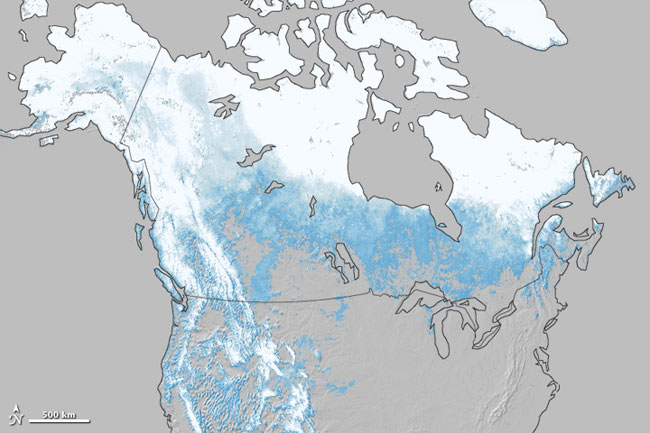
Old Man Winter Sets Several Strange Records

This past winter's teeth-chattering cold and holiday travel-wrecking blizzards packed quite a punch, but that wintery black eye faded unusually quickly in April, a new report says. Yet still in some places, showcasing the fickleness of climate and weather, winter has made some record-breaking last gasps.
By the end of April, snow cover over North America had melted to its lowest extent for that time of year since satellite measurements began in 1967, according to the National Oceanic and Atmospheric Administration's April 2010 State of the Climate report, released this week. A NASA satellite image for April 2010 shows large swaths of southern Canada with no snow on the ground.
Canada recorded its warmest and driest winter since records began in 1948 — with temperatures about 7 degrees Fahrenheit (4 degrees Celsius) above normal and precipitation down 22 percent, according to Environment Canada.
Oddly, though, this past winter set the record for the highest average extent of snowfall cover for North America — basically the footprint of snow — a measurement that dates back about 40 years.
"It's like the Norse god of winter saying 'I'm really going to hammer the United States,' and then telling the spring god, 'now you take over!'," said meteorologist Richard Heim of NOAA's National Climatic Data Center.
Snow cover for April 2010 was below average by about 850,000 square miles (2.2 million square kilometers) — roughly the size of Mexico. The lack of white stuff was due to April's unusually warm weather that halted snowfall and sped up the melt of snow on the ground, according to the NOAA report.
Meanwhile, Old Man Winter only hit the snooze button in some parts of the United States. On May 24, a snowstorm socked Salt Lake City, smashing records and freezing many of the state's fruit crops. The storm set a new record for the latest measureable snowfall — 0.2 inches (0.5 centimeters) — in the area, beating the old record set on May 18, 1960, when only 0.5 inches (1.3 cm) fell.
Sign up for the Live Science daily newsletter now
Get the world’s most fascinating discoveries delivered straight to your inbox.
The record for the coldest daily temperature in Salt Lake City was also set at 33 degrees F (0.5 degrees C). The previous record low was 36 degrees F (2 degrees C) on May 24, 1966.
The cold is bad news for Utah farmers, but ski resort owners couldn't be happier — at least those still open. Snowbird Ski Resort received six inches of snow between Sunday night, May 23, and Monday morning, May 24, reported the Salt Lake City Deseret News. The resort still has a snow blanket over 10 feet (3 meters) deep.
Farther West, most ski slopes in the Sierras stopped their lifts at the end of April, but Donner Ski Ranch west of Lake Tahoe, along the California-Nevada border, still has plenty of snow on the ground and will let skiers hit the slopes until the snow melts, resort owner Janet Tuttle told the San Francisco Chronicle. Tuttle said that they expect 6 or more inches of snow over the days leading up to Memorial Day weekend.
This past winter, dubbed "Snowpocalypse 2010," was called "the biggest winter storm in close to 90 years" the Wall Street Journal said. The blizzard buried the Eastern U.S. under 2 feet (0.6 m) or more of snow in many spots, including a record breaking 32 inches (81 cm) at Dulles International Airport in the nation's capital. Philadelphia had to dig out of 28.5 inches (72 cm) of snow, the second highest snowfall in the city's history. However, New York City's record of 25.5 inches (65 cm) of snow on Dec. 26, 1947 wasn't matched, and neither was Boston's 23.6-inch (60 cm) snowfall of Feb. 17, 2003.
As for the entire lower-48 United States, the greatest snowfall event ever recorded was 63 inches (160 cm) in Georgetown, Colo., on Dec. 4, 1913. The coldest temperature ever recorded was minus 70 degrees F (minus 57 degrees C) at Rogers Pass, Mont., on Jan. 20, 1954.
For North America, the all-time record cold temperature is mind-numbing: minus 81.4 degrees F (minus 63.0 degrees C), measured on Feb. 3, 1947 in Snag, Yukon Territory, Canada.
- 101 Amazing Earth Facts
- How Weather Changed History
- Quiz: Global Weather Extremes









